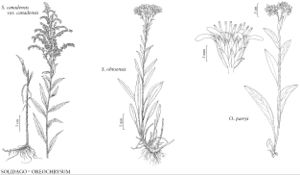Oreochrysum parryi
Bull. Torrey Bot. Club 33: 152. 1906.
Common names: Parry’s goldenweed
Illustrated
Basionym: Haplopappus parryi A. Gray Amer. J. Sci. Arts, ser. 2, 33: 239. 1862 (as Aplopappus)
Synonyms: Solidago parryi (A. Gray) Greene
Treatment appears in FNA Volume 20. Treatment on page 167.
Stems often purple proximally. Leaves (3–) 6–15 cm, sometimes slightly succulent, clasping or subclasping, less commonly non-clasping, relatively unreduced to arrays, distal sometimes grading into phyllaries. Ray corollas 6–10 mm. Disc corollas 7–9 mm, lobes spreading. 2n = 18.
Phenology: Flowering Jul–Sep.
Habitat: Moist to dry meadows and roadsides, wooded slopes, often in partially shaded understory
Elevation: 2400–3800 m
Distribution

Ariz., Colo., Nev., N.Mex., Utah, Wyo., Mexico (Chihuahua)
Discussion
Oreochrysum parryi was noted by A. Cronquist (1994, p. 244) to occur in “the Ruby Mts. of Elko Co., Nevada, in a glandular-puberulent, perhaps varietally separable phase.” (Chihuahua—collected by C. G. Pringle from a single locality; it has never been recollected.)
Selected References
None.
Lower Taxa
None.
"thickening" is not a number.
... more about "Oreochrysum parryi"
introrse +
connate +
distinct +
herbaceous +
scarious +
hirsute +
papillate +
continuous +
decurrent +
ribbed +
stigmatic +
barbellate +
persistent +
40;60 +
equal +
absent +
Parry’s goldenweed +
yellow +
absent +
monomorphic +
dimorphic +
plump +
staminate +
straight +
distinct +
proximal +
1;5 +
bisexual +
dispersed +
singly +
indeterminate +
Present +
non-resinous +
herbaceous +
lanceolate-oblong +
surrounding +
campanulate;hemispheric +
non-clasping +
alternate +
succulent +
spreading +
triangular +
viscid +
gland-dotted +
short-stipitate-glandular +
glabrous +
2-carpellate +
inferior +
attached +
anatropous +
persistent +
tough +
thick +
absent +
connate +
1-nerved +
persistent +
appressed +
distinct +
falling +
unequal +
Bull. Torrey Bot. Club +
1906 +
pistillate +
absent +
fertile +
epaleate +
pitted +
concave;usually flat;conic +
scale-leaved +
slender +
woody +
fibrous +
exalbuminous +
modifed +
2;3;4 +
Illustrated +
alternate +
simple +
purple +
erect +
2-branched +
glabrous +
Oreochrysum parryi +
Oreochrysum +
species +
tubular-funnelform +
shorter +
perennial +
